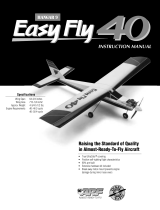Page is loading ...

The following pictures illustrate a completed step, or a combination of completed steps. Read the instructions on the plans
carefully and use the photos as a visual reference.
WING CONSTRUCTION

.
FUSELAGE
STABILIZER & RUDDER
WARNING - DANGER!
Important: Read These Warnings:
Do Not fly control-line or towline models within 300 feet of electric power lines. Instant death from electrocution can result from
coming near them. Direct contact is not necessary.
A model airplane motor gets very hot and can cause serious burns. Do not touch the motor during or after operation. Keep
clear of the propeller. It can cut off a finger or put out an eye. Make sure the propeller is securely fastened in place and is not
cracked. Model airplane fuel is flammable and poisonous. Take the same precautions while transporting and using it that you
would with a can of gasoline or bottle of poison.
It is possible to lose control of a model airplane. Do not fly in locations where the model may hit people or damage property if
loss of control occurs. Check your model and equipment regularly to insure it is in a safe operating condition.

.
FINAL ASSEMBLY
OFFICIAL AMA SAFETY CODE January 1, 1984
Model Flying Must Be In Accordance with This Code In Order for AMA Liability Protection to Apply.
GENERAL
1. I will not fly my model aircraft in competition or in the presence of spectators until it has been proven to be airworthy by
having been previously, successfully flight tested.
2. I will not fly my model higher than approximately 400 feet within 3 miles of an airport without notifying the airport operator.
I will give right-of-way to, and avoid flying in the proximity of full-scale aircraft. Where necessary, an observer shall be
utilized to supervise flying to avoid having models fly in the proximity of full-scale aircraft.
3. Where established, I will abide by the safety rules for the flying site I use, and I will not willfully and deliberately fly my
models in a careless, reckless, and/or dangerous manner.
4. If my model weighs over 20 pounds, I will only fly it in accordance with paragraph 5 of this section of the AMA Safety
Code.
5. At air shows or model flying demonstrations a single straight line must be established, one side of which is for flying, with
the other side for spectators. Only those persons essential to the flight operations are to be permttted on the flying side of
the line; all others must be on the spectator side. Flying over the spectator side of the line is prohibited, unless beyond the
control of the pilot(s).
The only exceptions which may be permitted to the single straight line requirement, under special circumstances involving
consideration of site conditions and model size, weight, speed and power, must be jointly approved by the AMA President
and the Executive Director. In any case, the maximum permissible weight of flying models is 55 Ibs.
6. I will not fly my model unless it is identified with my name and address or AMA number, on or in the model. Note: This
does not apply to models flown indoors.

.
7. I will not operate models with metal-bladed propellers or with gaseous boosts, in which gases other than air at normal
atmospheric pressure enter their internal combustion engine(s); nor willI operate models with extremely hazardous fuels;
such as those containing tetranitromethane or hydrazine.
8. I wiil not operate models wtth pyrotechnics (any device that explodes, bums or propels a projectile of any kind) including,
but not limited to, rockets, explosive bombs dropped from models, smoke bombs, all explosive gases (such as hydrogen-
filled balloons), ground mounted devices launching a projectile. The only exceptions permitted are rockets flawn in
accordance with the Safety Code of the National Association of Rocketry or those permanently attached (as per JATO
use); also those items authorized for Air Show Team used as defined by the AST Advisory Committee (document
available from AMA HQ).
Note: A modal aircraft is defined as a heavler-than-air craft, with or without engine, not able to carry a humin being.
RADIO CONTROL
1. I will have completed a successful radio equipment ground range check before the first flight of a new or repaired model.
2.
I wil not fly my model aircraft in the presence of spectators until I become a qualified flier, unless assisted by an experienced
helper.
3. I will perform my initial tum after takeoff away from the pit, spectator. and parking areas, and I will not thereafter perform
maneuvers, flights of any sort, or landing approaches over a pit. spectator, or parking area.
CONTROL LINE
1. I will subject my complete control system (including safety thong, where applicable) to an inspection and pull test prior to
flying.
2. I will assure that my flying area is safely clear of all utility wires or poles.
3. I will assure that my flying area is safely clear of all non-essential participants and spectators before permttting my engine to
be started.
FREE FLIGHT
1. I will not launch my model aircraft unless at least 100' downwmd of spectators and automobile parking.
2. I will not fly my model aircraft unless the launch area is clear of all persons except my mechanic and officials.
3. I will employ the use of an adequate device in flight to extinguish any fuses on the model after it has completed its function.
© Copyright SIG Mfg. Co., Inc.
SIG MFG. CO., INC............Montezuma, Iowa 50171
-
0520
LIMIT OF LIABILITY:
In use of our products, Sig Mfg. Co.'s only obligation shall be to replace such quantity of the product proven to be defective.
User shall determine the suitability of the product for his or her intended use and shall assume all risk and liability in
connection therewith.
/




